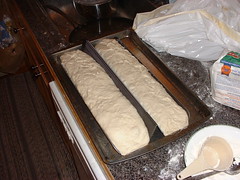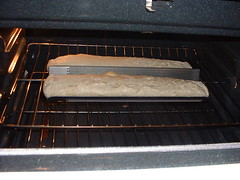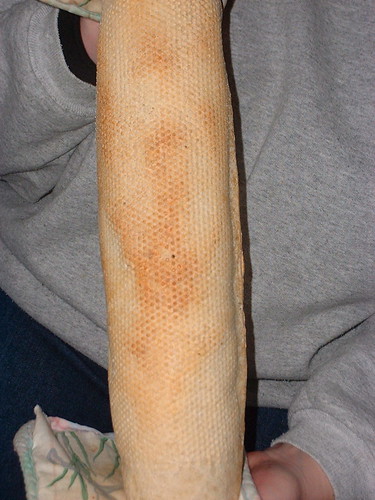Typical Saturday AM for MBH (My Better Half for those of you who haven't figured out the Three Letter Acronym) and I. We are at "Dammits", first ones in as usual, in our normal spot doing our normal thing: he, working on his computer and me, alternating between reading the paper and working on my computer. There is something comforting in a routine but there is also something disconcerting about the same routine. We, as humans, long for the security and sameness of a routine but at the same time feel the need to have something new and exciting.
This morning they were playing David Bowie's latest collection of "Greatest Hits" when we walked in and at first, I found it very grating on my nerves. I was hoping for something soothing and quiet to wake up my muse as I had planned to spend the morning working on my blog and my "Plan D" (more on that later). But, now as I listen to the music of my wicked youth, I can see myself as a "rebel" in my late teens/early 20's getting ready to go waste 8+ hours at school/work, blasting David Bowie, The Church, Depeche Mode hoping the depressing idea of numbing my mind doing menial labour would be soothed by the hidden messages I was sure only "I" understood in "Major Tom" or "The Jesus Song". I can see my room at my parent's home and see my bed covered in books like Ayn Rand's Anthem, Hemmingway's The Sun Also Rises, and some collection of Beat poets and I wonder "Where is that girl now"? And you know what, I was no different than today's "rebels" despite what I wanted to believe then and what they want to believe now. They are the girls behind the counter talking about how they woke up this morning to come into work and just "HAD" to hear Davie Bowie and now Depeche Mode and the kid sitting at the table next to me wearing today's latest chic clothing (that looks surprisingly like the chic wear of 1978) working on his homework for Comparative Religions of the Middle Ages for his class in the Divinity School at Harvard. They want to make sure that they don't end up working their lives away and not making what they do matter to the greater world. That they don't end up like their parents, doing the same thing day in/day out and they hope somewhere buried deep in the lyrics of Sir Bowie or Martin Gore lies the answer to how to avoid the sameness we all crave but don't want.
Pretty dark thoughts for a bright crisp winter day in Cambridge and maybe brought on by my early morning listening to Ira Glass's This American Life on NPR this morning. If you aren't familiar with this little gem of storytelling, you should check out an episode (the best of them are available for download and your listening pleasure). This week's episode is called "Plan B" and it was about people who are living their Plan B's and sometimes C's, D's, or even E's. It got me to thinking about my original Plan A and which plan I am living and is this really the plan I want to stick with (probably not). Plan A, Breadchick was to be the principal oboist for the Boston Symphony Orchestra. Seriously. I still remember when I decided that was what I was going to do. It was 1976 and I was sitting in the backseat of my parents 1973 Chevy station wagon and we were dropping my best friend Kari off at her house on a dark cold winter night after swim team practice. My hair was half frozen from the cold and Kari was telling my mom she had to practice the piano that night for a lesson and I remember feeling like I had been hit by a bolt of lightening because all I wanted to be able to do was go home and practice an instrument and I even knew which instrument I wanted to practice, the oboe. So, when my parents pulled out of the driveway I announced to my parents that I wanted to learn to play the oboe. I remember my mom looking at me in the back seat with this look of "what the hell are you talking about" and saying, "well don't you think maybe you should learn to play something else like the piano first? " I remember thinking, I don't WANT to learn to play the piano, I want to learn how to play the oboe. But, I was wise enough to understand that if you want to get what you really want sometimes you have to do something someone who is in charge wants you to do first. So, somehow, within a few weeks, my parents had found the extra money to let me start piano lessons and we had "rented" a piano from the local music store (we ended up buying that piano and it still is in the front room at my Dad's house in Illinois). Somehow within the next two years, I had persuaded my parents that I was ready to play the oboe; despite my mom's objection "because I didn't practice the piano so how was I going to practice the oboe" and a band teacher's objection because "you just don't START on the oboe". So, there I was, in 4th grade band, playing on plastic reeds on a plastic oboe sounding like some dead waterfowl that had been decomposing in some smelly backwater. Somehow my parents and the band teacher lived through those first few years and somehow, unlike the piano, I fell in love with practicing and playing the oboe. Next thing I know, I'm in high school and been playing the oboe for almost 10 years and I am on my way to Interlochen's National Music Camp (the Tanglewood for the world's young musicians) and on a collision course with the end of Plan A. Interlochen is where if you are the shark in your local pond you quickly find out if you will remain a shark or will become plankton. I found out that summer I would become plankton. My dreams of playing principal oboe for Arthur Fieldler and Leonard Bernstein came crashing to the ground when my oboe instructor at Interlochen asked me "so, what do you plan on doing with the rest of your life?" and then proceeded to laugh when I told him my Plan A. Now, before you get all indignant about that and think "how cruel, how could anyone do that?", you should know that the world of classical music is one of the most cut throat careers anyone could try. Basically, there are about 63 orchestras in the world that play year round and provide full time positions for musicians. In an orchestra, there are two (2) full time oboists and one part-timer who plays as a third or plays english horn when the score calls for one. So, let's do the math here, 63 x 2 means that 104 oboists in the world are employed full time by a major symphony orchestra. Soloist oboes who make a living are even rarer (despite the fact that we are the instrument the whole orchestra tunes to, including the violin, there just isn't the call for solo oboists). So, that means that the opportunities to make a living playing the oboe full-time are pretty limited. Basically you have to be the best of the best of the best to make it. And guess what, my instructor at Interlochen was right, I wasn't the best of the best of the best. I was good (you had to be to get accepted to Interlochen) but I just wasn't that good. And I like to think that Dr. Krause saw that I just didn't have the temperament for the career or the stomach. I loved to play but I hated the stress that came from auditions and the pre-concert jitters. It literally made me ill. I credit Dr. Krause with helping begin to form "Plan B", he told me to not stop playing the oboe. To just play it for me and fun and if I really wanted to stay in music, find something else to do in the music industry. And you know what, he was right and I did...thus, the beginnings of my path to acoustical engineer and Plan B. But more on that later.
Ok, so you are asking what in heaven's name does any of this rambling have to do with bread, food, or anything else "promised" by this blog? Not much, but since I also have begun to think about Plan D of my life (a plan that is likely to include bread), here is a recipe for you and it even includes Sourdough starter and is the result of a recipe I developed by not wanting to waste some "toss off" from a really active starter. Kind of like my Plan B being the result of not wanting to waste the "toss off" from Plan A....
Breadchick
SOURDOUGH SWEET ROLLS WITH BUTTER CREME FROSTING
Prep Time: 2 Days
This recipe uses the sponge method for a first rise followed by a second standard rise before you roll out dough for the rolls. Your sourdough starter should be well established as well to give the best results. Also, the temperature of the room you are baking in should be between 75 and 80 degrees. If room is colder, double the rising times. If kitchen is warmer, use a retarded rise method by placing dough in refrigerator (this method will take some watching of dough. expect 2 to 2.5 times longer on rises). This recipe is suited for either hand mixing or standing mixers.
This recipe results in 15 - 20 good sized rolls with a tangy sweet taste.
This recipe may be used to make cinnamon, gooey caramel or pecan caramel rolls (recipes for fillings are below).
INGREDIENTS FOR SWEET DOUGH:
1 C. sourdough starter
3/4 C. sugar
1/2 C. canola or vegetable/canola blend oil
1 Tbsp. salt
1 1/2 C. warm water (80 - 85 Degrees)
6 1/4 to 6 1/2 C. bread flour (depending on stiffness of batter, hold back 1/4 cup)
INGREDIENTS FOR FILLINGS:
Cinnamon Rolls:
1 C. Sugar
4 tbsp. Cinnamon (or to taste)
1 C. Raisins (Optional)
Orange Zest (Optional/to taste if you want Orange/Cinnamon rolls)
1/4 C. Melted Butter (to brush on rolled out dough)
Gooey Caramel Rolls:
1/2 C. Light Brown Sugar (packed)
1/2 C. Sugar
4 tbsp Cinnamon (or to taste)
1/4 tsp Salt (optional or to taste)
1/4 C. Melted Butter(to brush on rolled out dough)
Caramel Pecan Rolls:
1 - 1 1/2 C Pecans (lightly toasted and chopped coarsely)
1/2 C. Light Brown Sugar (packed)
1/2 C. Sugar
4 tbsp Cinnamon (or to taste)
1/4 tsp Salt (optional or to taste)
1/4 C. Melted Butter(to brush on rolled out dough)
INGREDIENTS FOR BUTTER CREME FROSTING
1/2 stick butter very soft but not melted
1/8 Cup Milk
2 Cups of Confectioner Sugar
1/2 tsp Vanilla Extract (or other flavoring of your choice. Almond or Orange is very nice on the Cinnamon Rolls!!)
Blend well adding more sugar if necessary until frosting is creamy and very spreadable
STEP 1: MAKING THE SPONGE
Combine the starter, the water and one half the flour (without 1/4 Cup held back in reserve) in a large glass or plastic bowl(Don't use a metal bowl as the starter will "react" to the metal). Cover loosely with plastic wrap and let rise at room temperature for at least 3 hours or until almost tripled.
STEP 2: MAKING THE SWEET DOUGH
Mix the sugar and salt together in small bowl. Stir down the sponge and add the oil and 1/2 the sugar/salt mixture to the sponge. Stir well until all the oil is almost absorbed by the dough. Add 2 cups of the flour and mix well until the dough is smooth. Add the rest of the sugar/salt mixture and 1/2 cup of the flour and mix well until combined fully. You may need to switch to hand mixing here if your dough is starting stiffen or if your standing mixer is starting
to strain, switch to the dough attachment. Add remaining flour (without 1/4 Cup held back in reserve). At this point you may find you have to use your hands to combine this flour. Dough should feel sticky but stiff. If the dough feels too loose or wet, add the 1/4 Cup of flour you held back held back slowly until dough feels right. Mix well by hand until dough is smooth and elastic. Dough will still be slightly sticky. Resist the temptation to add more flour as this will result
in tough rolls.
Place dough in a very large buttered glass or plastic bowl. Cover loosely with plastic wrap and let rise for 8 - 12 hours or until at least doubled or almost tripled.
Step 3: FORM THE ROLLS
Divide the dough into 2 halves and cover the half not being worked with plastic wrap and return to bowl. Turn the half of dough you are working with onto a floured surface for rolling and form into rough rectangle. Begin rolling dough out to form 15" x 6" rectangle that is about 1/2" thick. If dough springs back as your rolling use your hand to press into rectangle and roll out slowly. You will depress air pockets out of dough and the dough will be slightly resistant to rolling.
You may also have to let dough "rest" and relax between some rolls for a minute or two. Be patient, dough will relax. Also, be careful to not overwork the dough or add too much flour as you are rolling.
When you have dough rolled out, brush dough with melted butter; not too much or the sweet roll will "fall apart" during last rise. Just enough for filling to cling to dough. Generously sprinkle the filling of your choice from one long edge to the other, leaving about 1/4" of one long edge free of filling. Roll the dough slowly to form a long "roll". Pay attention to keeping "ends" of the roll as even as possible, working the ends to be even is necessary until all that is left to roll is
the 1/4" long edge border without filling. Brush water or an egg white wash on this 1/4" and seal the roll; gently pinching the roll to seal if necessary.
Using dental floss, cut the long roll into 1 1/2" - 2" sections and place in well buttered 13" x 9" glass baking dish.
Repeat method with remaining dough. (You may need to also use a second baking dish)
Cover baking dish with plastic wrap and let rise 8 - 12 hours or until rolls are almost doubled.
Step 4: BAKING/FROSTING
Bake Rolls at 350 Degrees for 45 minutes or until internal temperature of roll is 190 degrees.
Let completely cool (1 to 2 hours) and frost.
Note: If you make the gooey caramel or caramel pecan rolls, the caramel will set. To loosen from dish, set baking dish in pan of hot water for a few minutes before serving. These two rolls are also best served a bit warm. About 20 seconds in the microwave is about right to make them warm but the fillings not too hot.
Also, don't try and halve this recipe. If it makes too many rolls for you, just bake them and freeze them without frosting them. When you want a gooey roll, take a few out of the freezer, let them come to room temperature and frost them.











